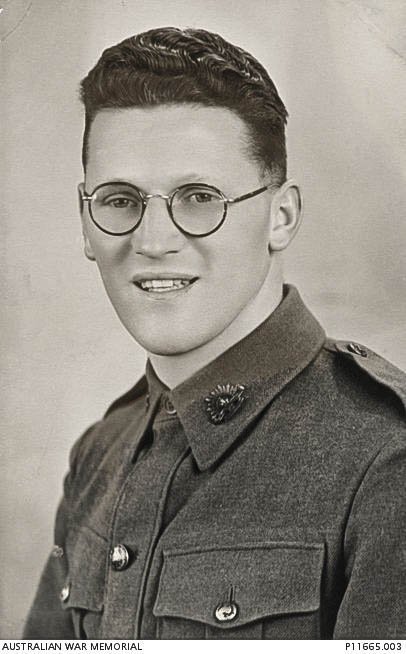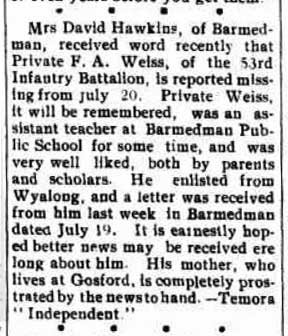The Weiss family back home
Missing for months, Fred’s family would have been grief stricken only to be told more than a year later that he had been killed in action. And his bombardier brother, Erle, was in the frontline at the same time. What a dreadful time for them all. The newspaper excerpt (at right) hints at the anguish the family suffered. Poignantly, it also refers to a letter to friends living in Barmedman where Fred had been teaching prior to his West Wyalong posting; the letter was written on the day that he died.
In total, there were seven siblings back home – three sisters (Grace, Amy and Lorna) and four brothers (Hector, Walter and the twins born in 1910, Howard and Harry). Hector had tried to enlist as his elder brothers had done but was rejected on physical fitness grounds.
The Weiss boys who went to war
Of the Five brothers, three of the Weiss boys did not return home.
3587A Frederick Alfred WEISS born 16 October 1892

53rd Battalion - killed in action 19 July 1916 at Fromelles, France. No known grave. Aged 23.
11147 ERLE VICTOR WEISS born 8 Nov 1894

1st Field Artillery Brigade - killed in action 9 August 1918 at Bayon-villers, Somme, France. Aged 23.
Erle Victor Weiss, two years younger than Fred, enlisted a month after Fred in August 1915. He had been working as a draper’s assistant in Singleton. Assigned to the 1st Field Artillery Brigade, Erle was promoted from gunner to acting bombardier and served nearly 3 years, mostly on the Western Front.
On several occasions, Erle was reported as unwell including being severely gassed in November 1917. He was returned to England for treatment and then was back in France in May 1918. He was killed in action on 8 August 1918, just three months shy of his 24th birthday – almost the identical age that Fred was killed. Initially, Erle was buried in the Bayonvillers German cemetery in France but was later exhumed and buried at the Heath Cemetery at Harbonnieres in France. More on Erle’s individual story can be found at https://cassmobfamilyhistory.com/2013/11/11/remembrance-day-2013-erle-victor-weiss/
In a letter dated 12 November 1918 (the day after the signing of the armistice to officially end the war), Erle’s father, Walter, wrote to authorities querying the return of Erle’s personal effects:
“….my wife and I are very anxious to receive them. We have lost our two sons on active service, and peace brings with it no hope for the return of our dear ones, our eldest boy was posted ‘missing’ for 12 months, and we long for something personal from our second son’s effects.”
Eventually, after many letters from Walter, Erle’s personal effects – one parcel containing 2 photos, 1 card, 1 belt, 1 pocketbook, 1 wallet (damaged), and 1 scarf - were returned to his parents. It is believed that nothing of Fred’s was ever recovered.
NX36483 HARRY BLANCH WEISS born 1 April 1910

2/30th Battalion – prisoner of war, died of illness on 30 September 1943 on Burma-Thai railway. Aged 33.
Harry, one of the young twins who were the last-born of the Weiss children, was a bank teller with the Commercial Banking Co. prior to enlistment during World War II. He fought in Malaya and was taken prisoner during the fall of Singapore in February 1942. After seventeen months as a prisoner of war in Singapore, Burma and Thailand, Harry died of illness in September 1943 on the infamous Burma-Thailand railway. He is buried at the Thanbyuzayat War Cemetery in Burma.
Thirty-three when he died, Harry left the wonderful legacy of a diary - truly treasured by family - that described his experiences as a prisoner. The diary was published by the local paper in serial form from November 1946 to March 1947. In an article introducing the serialised diary, the Singleton Argus describes the diary as:
“written in an old Wireless Operator's Log Book, firstly in ink, then in pencil, and later in a green home-made ink made from distilled hybiscus flowers.”
And it also points out that
“This diary is not one of horror, but an interesting account of the everyday happenings of an ordinary good Australian—his thoughts, his experiences, his hopes. It shows how men—the men of our town, and other towns like it—reacted in that strange environment, the initiative they used, the results they achieved.”
It is well worth seeking out the articles on Trove for a glimpse of Harry’s daily life as a prisoner of the Japanese.
N413820 HECTOR VIVIAN WEISS born 25 September 1896
At age 19, Hector, then a grocer’s assistant, attempted to enlist in about 1915 but was rejected on physical grounds. He was however successful in enlisting during World War II signing up in the volunteer defence corps in May 1942, aged 45. He married in 1926, worked as a grocer and died in 1962 aged 65.
NX95505 HOWARD GLENDON WEISS born 01 April 1910
Twin to Harry who died in Burma, Howard (or Glen as sometimes known) also enlisted during World War II. He survived the war to marry and raise a family. He worked as a bank officer and bank manager and died in 2004, aged 94
Fred’s parents – Amy and Walter
Amy Selina nee Blanch 1873-1925, Fred’s mother, was a homemaker and mother to nine children and she is sweetly described in her obituary:
“Mrs. Weiss was one of those quiet Christian women whose light shone most brightly in the home circle, rather than in the wider activities of Church life, but one and all, whoever entered that home, bear unstinted testimony to the sweet and gracious influence exercised in all the family relationships. Her husband is one of the most active and acceptable local preachers in the Gosford circuit, and his many good works were made possible by the support and sympathy afforded him by his good wife. Mrs. Weiss was born at Anna Bay, Port Stephens, in 1873, being the daughter of Mr. and Mrs. Alfred J. Blanch. It was there she met her future husband, who was in charge of the school….”
In contrast, Fred’s father was very active in his local community. Walter Herbert Weiss 1869-1955 was a teacher and headmaster in Anna Bay, Glendon Brook, Erina and other country schools for over 50 years. Walter was also a lay preacher in the Methodist Church (including some time on Norfolk Island) and a keen tennis player into his 80s. He was also instrumental in the building of the Erina War Memorial being the president of the organizing committee.
